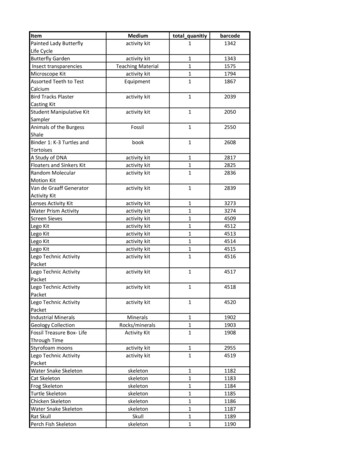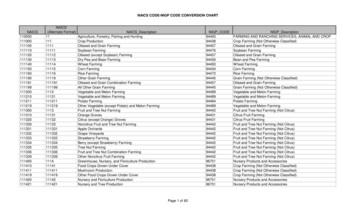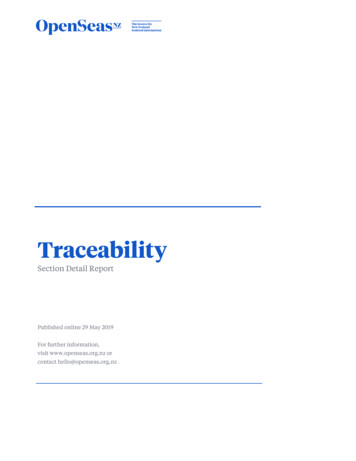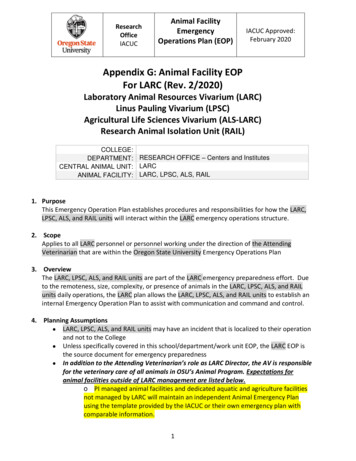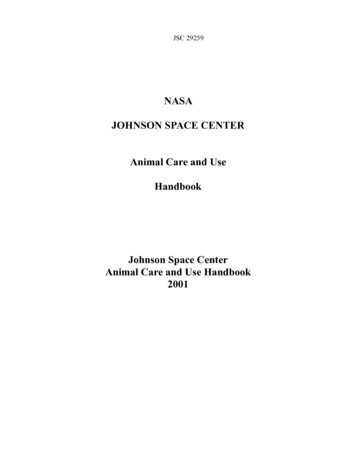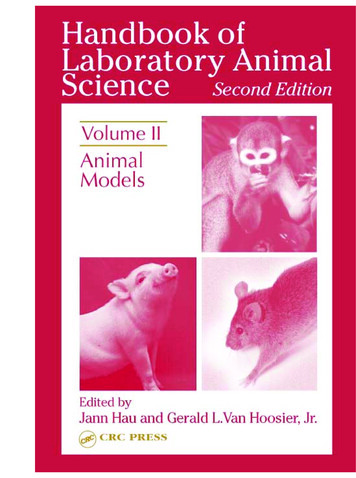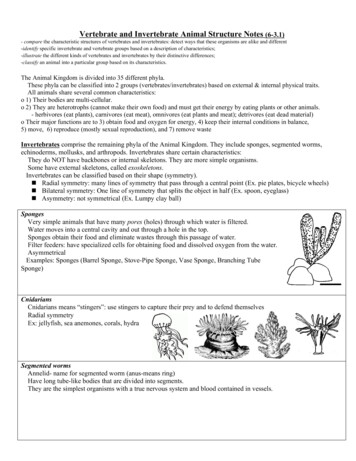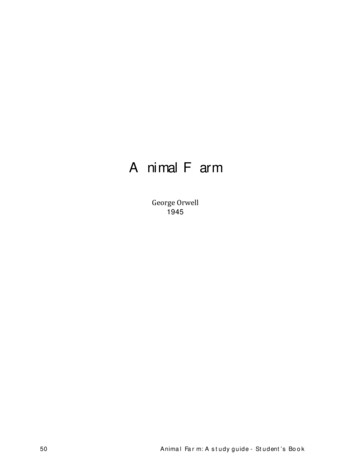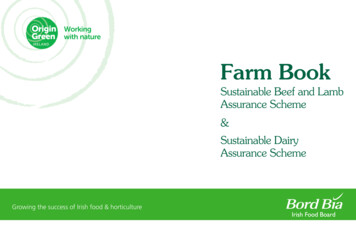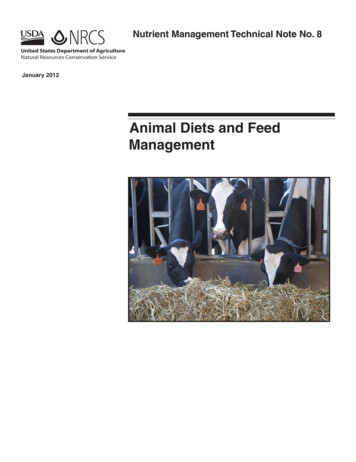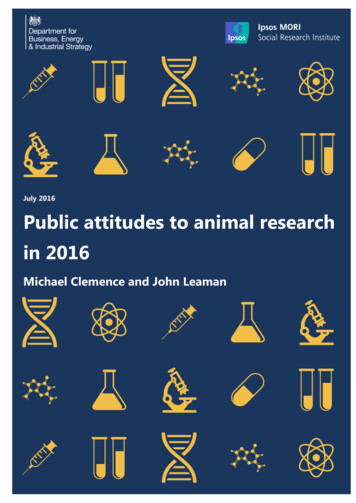
Transcription
July 2016Public attitudes to animal researchin 2016Michael Clemence and John Leaman15-083519-01 This work was carried out in accordance with the requirements of the international quality standard for Market Research, ISO 20252:2012, and with the Ipsos MORI Terms and Conditionswhich can be found at http://www.ipsos-mori.com/terms. Office for Life Sciences 2016
Ipsos MORI Public attitudes to animal research – 2016 report15-083519-01 This work was carried out in accordance with the requirements of the international quality standard for Market Research, ISO 20252:2012, and with the Ipsos MORI Terms and15-083519-01 This work was carried out in accordancewith therequirementsof theinternational quality standard for MarketResearch,ISO 20252:2012,Conditionswhichcan be foundat http://www.ipsos-mori.com/terms. Officefor Life Sciences2016 and with the Ipsos MORI Terms and Conditionswhich can be found at http://www.ipsos-mori.com/terms. Office for Life Sciences 2016
Ipsos MORI Public attitudes to animal research – 2016 reportTable of ContentsIntroduction and summary . 11 Methodology . 31.1Overview. 31.2Reporting conventions . 32 Public views on the use of animals in research. 42.1General attitudes towards animal research . 42.2Support for research using different animal species . 82.3Public awareness of what is allowed in animal research .113 Public views on regulation and behaviour . 133.1Views on the regulation of animal research .133.2Views on individuals and organisations involved in animal research .164 Protesting against animal research . 194.1Initial considerations .194.2Further considerations .204.3Acceptability of demonstrating against animal research .225 Information about animal research . 245.1How informed do the public feel about animal research? .245.2Awareness of NC3Rs .285.3Trusted and preferred sources of information on animal research .30Appendix One – Statistical reliability . 36Appendix Two – Demographic information . 38Appendix Three – Questionnaire . 40Appendix Four – Survey topline results . 4715-083519-01 This work was carried out in accordance with the requirements of the international quality standard for Market Research, ISO 20252:2012, and with the Ipsos MORI Terms and Conditionswhich can be found at http://www.ipsos-mori.com/terms. Office for Life Sciences 2016
Ipsos MORI Public attitudes to animal research – 2016 reportList of FiguresViews on the acceptability of animal research I . 5Views on the acceptability of animal research II . 6Views on the acceptability of animal research III . 7Views on the use of animals in non-medical research. 8And which, if any, types of animals do you think it is acceptable to use for. .10The public acceptability and legal permissibility of different types of research .11Attitudes to the regulation of animal research .14Views on the level and quality of regulation .16Public views of animal research organisations .17Public views of animal research and researchers .18Acceptability of protest actions I .20Acceptability of protest actions II .21The acceptability of different types of demonstration .23Public information about animal research and developments .25Recalled stories about animal research .26Public interest in work to find alternatives to animal research .27Public interest in work to improve the welfare of animals used in scientific research .28Public awareness of the “three Rs” of animal research.29Public awareness of the NC3Rs .30Preferred methods of communication about animal research I .31Preferred methods of communication about animal research II .33Trust in individuals and organisations to give balanced information .34List of TablesTable 2.1: Views on legal permissibility and acceptability of using animals in cosmetic testing – agebreakdown .12Table 3.1: Relationships between age and trust in scientists and the regulatory system .15Table 5.1: Sampling tolerances for the survey .36Table 5.2: Subgroup confidence intervals .36Table 5.3: Between-wave comparison confidence intervals .37Table 5.4: Demographic profile of 2016 sample .3915-083519-01 This work was carried out in accordance with the requirements of the international quality standard for Market Research, ISO 20252:2012, and with the Ipsos MORI Terms and Conditionswhich can be found at http://www.ipsos-mori.com/terms. Office for Life Sciences 2016
Ipsos MORI Public attitudes to animal research – 2016 report1Introduction and summaryIntroduction to the surveyThis report presents the findings of the 2016 survey into public awareness of, and attitudes towards, the use of animals inscientific research.This is the second wave of a tracker survey initially conducted in 2014, which was also conducted by Ipsos MORI. Bothwaves were conducted using Ipsos MORI’s face-to-face “Capibus” survey vehicle, allowing for greater robustness in crosswave comparisons. The 2014 survey was broadly based on a long-term trend survey running from 1999; however, in 2014a qualitative analysis of this long-term survey was conducted and the questions were reviewed and updated to reflect thechanged context from when first asked in 1999. This new survey was run alongside the previous survey wave in 2014 tocheck for comparability of results to measure the impact of the new wordings. The comparison showed that therewording did not have a significant impact on question response, however as the questions were different, directcomparisons between pre-2014 data and this year’s results are not possible, and so have not been included.Summary of findingsThis year’s wave of the survey finds public views towards animal research to be broadly similar to those of 2014: there isbroad public acceptance of the use of animals in scientific research for medical and scientific purposes, but acceptance isconditional and dictated by the context of the research, and the animals that are under consideration. Public opinion isalso dependant on context: 35 per cent think that animals should not be used in any scientific research on ‘animal welfare’grounds, compared to 26 per cent who are in favour of a ban on the use of animals for any form of research when theterm “animal welfare” is not used.Public views on the use of animalsPublic attitudes towards the use of animals in research has shifted little between 2014 and 2016. A majority (65%) say theycan accept the use of animals in research as long as it is for medical purposes and there is no alternative, down (but notstatistically significantly) from 68 per cent in 2014; while support for an outright ban on animal research stands at 26 percent, up from 23 per cent in 2014, although this too is not a significant difference. However, this support is caveated; whilemedical and scientific research both attract majority acceptance, the public are less accepting of using animals in ‘all types’of research, and there is a less than majority acceptance of all forms of non-medical chemical testing. When asked toconsider which animals are most acceptable for use for a range of research purposes, rats and mice continue to head thelist.Many people continue to believe that cosmetics testing on animals is allowed in the UK (35% - up from 31% in 2014), andindeed more people this year think it should be allowed (9% - up from 5%).Public views on regulation and behaviourA sizeable proportion of the public neither agree nor disagree with the statements regarding the rules and regulationsaround animal research - which could suggest uncertainty about how the system works. One third (34%) say they neithertrust nor distrust the regulatory system governing animal research in the UK, the same as the proportion who agree that15-083519-01 This work was carried out in accordance with the requirements of the international quality standard for Market Research, ISO 20252:2012, and with the Ipsos MORI Terms and Conditionswhich can be found at http://www.ipsos-mori.com/terms. Office for Life Sciences 2016
Ipsos MORI Public attitudes to animal research – 2016 report2they do not trust the regulatory system. However, a majority agree that the UK has strict rules governing the use ofanimals in research; 52 per cent agree and just 13 per cent expressly disagree with this statement.Animal research organisations are widely viewed as secretive; 42 per cent selected this attribute from a list of positive andnegative options. The overall public view of these organisations is mixed, with one third (34%) selecting only negative traitsto describe them, and another third (34%) selecting only positive traits.Protesting against animal researchPublic support for the most acceptable forms of protest by animal protection organisations (handing out leaflets,organising petitions, writing letters and asking people to put stickers or posters in their window) is very similar to 2014 –each is endorsed by around 70 per cent. One in ten (11%) of the public now say animal protection organisationsdemonstrating outside the homes of those who work in animal research facilities is an acceptable strategy – up from 6 percent in 2014. Also up is endorsement of publicising (without their knowledge) the identities of animal researchers (from5% to 9%).Information about animal researchA majority of the public do not feel well informed about the use of animals in research in the UK – 34 per cent say theyfeel either very or fairly well informed. While television remains the most popular medium for finding out more aboutanimal research, a quarter of the public (28%) report having no interest in finding out more.Interest in finding out about work to improve the welfare, and find alternatives to the use of, animals in scientific researchhas remained static, with just over half saying they are interested (54% / 55% respectively). Awareness of recent newsabout the use of animals in research is low too; marginally over three quarters (76%) are unable to recall any stories theyhave heard in the news on the topic in the past twelve months.Vets who look after animals used in research are the most trusted source of balanced information about this field. Therehas been a marked decline in the proportion who say they would trust medical research charities (from 28% to 22%),whilst trust in the NHS on this topic has risen significantly (from 22% to 26%).15-083519-01 This work was carried out in accordance with the requirements of the international quality standard for Market Research, ISO 20252:2012, and with the Ipsos MORI Terms and Conditionswhich can be found at http://www.ipsos-mori.com/terms. Office for Life Sciences 2016
Ipsos MORI Public attitudes to animal research – 2016 report31 Methodology1.1 OverviewA sample of 987 adults aged 15 from across Great Britain was interviewed between 4th March and 4th April 2016, usingIpsos MORI’s “Capibus” vehicle – a face-to-face omnibus survey that uses a form of random location sampling to producea high-quality representative sample. This is the same methodology and survey vehicle used in 2014, allowing for robustcomparisons over time.The final data has been “weighted” by gender, age, region, ethnicity, working status and social class to reflect the exact15 population profile of Great Britain.The research carried out for this project has been in compliance with the Market Research Society (MRS) / ESOMAR Code,the Data Protection Act, and ISO 20252.1.2 Reporting conventionsPercentage PointsReference is sometimes made to “percentage points”. This describes a numerical difference between two percentagefigures - rather than an increase / decrease. For example, if awareness among one sub-group is 60% and in another is70% this is a difference of 10 percentage points, but not of 10 per cent (which would be 60% and 66%).Net scoresAt some points in the report “net scores” are used to describe results. A net score is calculated, for example, bysubtracting the proportion who disagree with a given question from the proportion who agree, resulting in a score thatcan range from -100% to 100%. A score above zero denotes that a larger proportion of the sample agree with a givenstatement than disagree with it, whilst a score below shows the opposite – that a larger proportion disagrees than agreeswith the question or statement. Net scores are calculated from full data and then rounded, which can sometimes meanthat there appears to be slight discrepancies between the figures reported as net scores and the sum of percentages;however, the figures are correct and the discrepancy is only due to the rounding of data.Publication of DataAs Ipsos MORI has been engaged to undertake an objective programme of research, it is important to protect our clients’interests by ensuring that it is accurately reflected in any press release or publication of findings. As with all our studies,and as part of our Standard Terms and Conditions, the publication of the findings of this report is therefore subject to theadvance approval of Ipsos MORI. Such approval will only be refused on the grounds of inaccuracy or misrepresentation.The full data set has been published alongside this report. This can be found on the UK Data Service website.15-083519-01 This work was carried out in accordance with the requirements of the international quality standard for Market Research, ISO 20252:2012, and with the Ipsos MORI Terms and Conditionswhich can be found at http://www.ipsos-mori.com/terms. Office for Life Sciences 2016
Ipsos MORI Public attitudes to animal research – 2016 report42 Public views on the use of animals inresearchKey findingsPublic attitudes towards the use of animals in research have shifted little between2014 and 2016. A majority (65%) say they can accept the use of animals in research aslong as it is for medical purposes and there is no alternative, whilst support for an outrightban on animal research stands at 26 per cent.Provisos remain however – whilst medical and scientific research both attract majorityacceptance, the public are less accepting of using animals in all types of research, andthere is a less than majority acceptance of all forms of non-medical chemical testing.Rats and mice continue to head the list of animals the public find acceptable for usein scientific and medical research. When asked to consider specific animals, betweenone quarter and one third say they cannot accept the use of any listed animals in scientificor medical research.2.1 General attitudes towards animal researchPublic acceptance of animal researchPublic acceptance of animal research remains largely unchanged from 2014, with a majority saying they are accepting ofthe use of animals in research; however the level of acceptability differs somewhat depending on the purpose.Two thirds (65%) of the public say they can accept the use of animals in research so long as it is for medical researchpurposes and there is no alternative, and a slightly higher proportion (71%) say they can accept the use of animals inscientific research so long as there is no unnecessary suffering and there is no alternative. This is a similar level ofacceptance as in 2014, when 68 per cent and 69 per cent respectively agreed.Public acceptance remains conditional, however. A smaller proportion – four in ten of the public (39%) – agree that it isacceptable to use animals in all types of research where there is no alternative, with a very similar proportion (40%)disagreeing and one in five (20%) unsure. This conditional approach to acceptance is underlined by the fact that amajority of the public say they are bothered by the use of animals in research – 59 per cent disagree that it does notbother them if animals are used in experimentation (identical to 2014), whilst one in five (22%) agree that it is not aconcern to them.15-083519-01 This work was carried out in accordance with the requirements of the international quality standard for Market Research, ISO 20252:2012, and with the Ipsos MORI Terms and Conditionswhich can be found at http://www.ipsos-mori.com/terms. Office for Life Sciences 2016
5Ipsos MORI Public attitudes to animal research – 2016 reportViews on the acceptability of animal research IViews on the acceptability of animal researchHow strongly do you agree or disagree with these general statements about the use of animals in scientific researchin the UK? 2014 – 2016 TRENDStrongly AgreeTend to agreeNeither/norI can accept the use of animalsin scientific research as long asthere is no unnecessarysuffering to the animals andthere is no alternative201627201426I can accept the use of animalsin scientific research as long asit is for medical researchpurposes and there is noalternative2016It is acceptable to use animalsfor all types of research wherethere is no alternativeIt does not bother me if animalsare used in 9147149822319186152029Don't know1443212016Strongly Disagree44232014Tend to disagree262730171152321292Base sizes:2016: 987 British adults; 2014: 969 British adults15-083519-01 OLS Public attitudes to animal research 2016 April 2016 FINAL Internal Use Only10Acceptance of animal research on these measures varies to an extent by demographic factors. Men are typically moreaccepting of the use of animals in research than women (a familiar pattern from many other studies); 71 per cent of mencan accept the use of animals in research for medical purposes where there is no alternative (compared to 60% of womenoverall, and just 49% of women aged 15-34). Close to half of men (47%) agree that it is acceptable to use animals for alltypes of research where there is no alternative, against one third (32%) of women. This figure rises to 55 per cent for menaged 55 and over.Men are also more likely to say it does not bother them that animals are used in experimentation; three in ten (30%) sayso, a figure just over twice that recorded for women (14%).Views are similarly unchanged in regards to using animals in research to help understand animal health and the humanbody – almost two thirds (64%) can accept using animals in research to help understand animal health, and 57 per centsay the same in regards our understanding of the human body - in cases where there is no alternative. These figures havenot changed significantly from the levels recorded in 2014 (64% and 60% respectively).15-083519-01 This work was carried out in accordance with the requirements of the international quality standard for Market Research, ISO 20252:2012, and with the Ipsos MORI Terms and Conditionswhich can be found at http://www.ipsos-mori.com/terms. Office for Life Sciences 2016
6Ipsos MORI Public attitudes to animal research – 2016 reportViews on the acceptability of animal research IIViews on the acceptability of animal researchHow strongly do you agree or disagree with these general statements about the use of animals in scientific researchin the UK? 2014 – 2016 TRENDStrongly agreeTend to agreeNeither/norTend to disagree20161839201417432016It is acceptable to useanimals in research to helpour understanding ofanimal health, where thereis no alternative 201417It is acceptable to useanimals in research to helpour understanding of thehuman body, where thereis no alternative15Strongly disagree174749Don't know13181217189910292817 1Base sizes:2016: 987 British adults; 2014: 969 British adults15-083519-01 OLS Public attitudes to animal research 2016 April 2016 FINAL Internal Use Only12There is slightly wider acceptance of using animals to help understand animal health than for understanding the humanbody, perhaps because it is more immediately obvious how research using animals has applications to understandinganimal health or that some feel ethically that the former is more acceptable. However, there are some differences inacceptance between demographic subgroups: While there are no significant differences across age groups in acceptance of using animals in research to helpunderstand animal health, the acceptance of animals in research to help understand the human body ranges from46 per cent for those aged 25-34 to 64 per cent for those aged 55 and over. Men are more accepting of both uses of research than are women, and the gap between them in accepting animaluse to benefit human health rises from thirteen percentage points (64% of men versus 51% of women) to twentypercentage points in regards work to understand animal health (74% compared to 54%). In both these cases and in regard animal research generally, those from social grades AB are substantially moresupportive than those from social grades DE.Support for restricting animal research and work on alternativesA majority of the public agree that more needs to be done to find alternatives to using animals in research – this yearthree quarters (74%) of the public agree, a similar level to 2014 when 76 per cent agreed. As in 2014, half (53%) of thepublic agree that the use of animals in medical research should be conducted only for life-threatening or debilitatingdiseases, with one quarter (24%) disagreeing.15-083519-01 This work was carried out in accordance with the requirements of the international quality standard for Market Research, ISO 20252:2012, and with the Ipsos MORI Terms and Conditionswhich can be found at http://www.ipsos-mori.com/terms. Office for Life Sciences 2016
7Ipsos MORI Public attitudes to animal research – 2016 reportThe proportion who agree that the UK Government should ban the use of animals for any form of research has risen since2014, but the difference is not significant; just over one quarter (26%) agree with this statement, compared to 23 per centin 2014. The proportion who disagree with this statement is identical to that of 2014, with a thin majority (53%)disagreeing with the statement. There has also been a similar-sized (but not significant) increase in the proportion whothink that animals should not be used in scientific research on animal welfare grounds – from 31 per cent in 2014 to 35per cent this year.Views on the acceptability of animal research IIIViews on the acceptability of animal researchHow strongly do you agree or disagree with these general statements about the use of animals in scientific researchin the UK? 2014 – 2016 TRENDStrongly AgreeThere needs to be more workdone into alternatives to usinganimals in scientific researchThe use of animals for medicalresearch purposes should onlybe conducted for life threatening or debilitatingdiseasesI think that animals should notbe used in any scientificresearch because of theimportance I place on animalwelfareThe UK government should banthe use of animals for any formof researchTend to 20162014Strongly Disagree35372619121122162527201422193 2217223614Don't know18361211Tend to disagree284 111011011311223122232212Base sizes:2016: 987 British adults; 2014: 969 British adults15-083519-01 OLS Public attitudes to animal research 2016 April 2016 FINAL Internal Use Only14Support for a UK Government ban on using animals in any form of research is highest amongst those from social gradesDE (34%), those with no formal educational qualifications (35%), and women aged 15-34 (37%). Views from thesesubgroups have not shifted dramatically since 2014 (at that point support for a ban in these groups stood at 30%, 34%and 38% respectively), which suggests that the small significant shift in opinion that has been registered this year is morewidely spread amongst the public at large.Those who disagree with a ban tend to be older and male – 58 per cent of men oppose it, compared to 47 per cent ofwomen, rising to 65 per cent of men aged 55 . Again, this pattern echoes much other research on animal welfare issues.Newspaper readership is also an indicator (corresponding as it often does with social class) – with majorities of bothbroadsheet and mid-market papers disagreeing with a ban (65% and 63% respectively), against 45 per cent of tabloidreaders. Even among this last group, though, more oppose than support a ban (45% vs 28%).Views on animal research for non-medical purposesPublic acceptance of the use of animals in scientific research is lower for research that is non-medical in its nature. 38 percent agree that they can accept the use of animals in scientific research to test chemicals that could harm people and 3615-083519-01 This work was carried out in accordance with the requirements of the international quality standard for Market Research, ISO 20252:2012, and with the Ipsos MORI Terms and Conditionswhich can be found at http://www.ipsos-mori.com/terms. Office for Life Sciences 2016
8Ipsos MORI Public attitudes to animal research – 2016 reportper cent say the same for chemicals that could harm pets, farm animals or wildlife, with one quarter (25%) agreeing thatthey could accept the use of animals in research to test chemicals that could harm plants or the environment.Acceptance is notably weaker for this last option, and it is the only one of the three where a majority of the public (50%)say they cannot accept the use of animals in this research.Views on the use of animals in non-medical researchViews on the use of animals in non-medical researchIt is acceptable to use animals in scientific research to test. 2014 – 2016 TRENDStrongly agreeTend to agreeNeither/nor201610282014833 chemicals thatcould harm pets,farm animals orwildlife2016820146 chemicals thatcould harm plantsor theenvironment2016520144 chemicals thatcould harm peopleTend to disagree21192123232520212332Don
Ipsos MORI Public attitudes to animal research - 2016 report 2 15-083519-01 This work was carried out in accordance with the requirements of the international quality standard for Market Research, ISO 20252:2012, and with the Ipsos MORI Terms and Conditions
